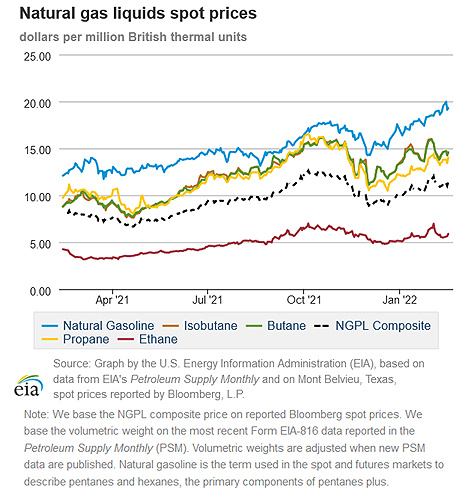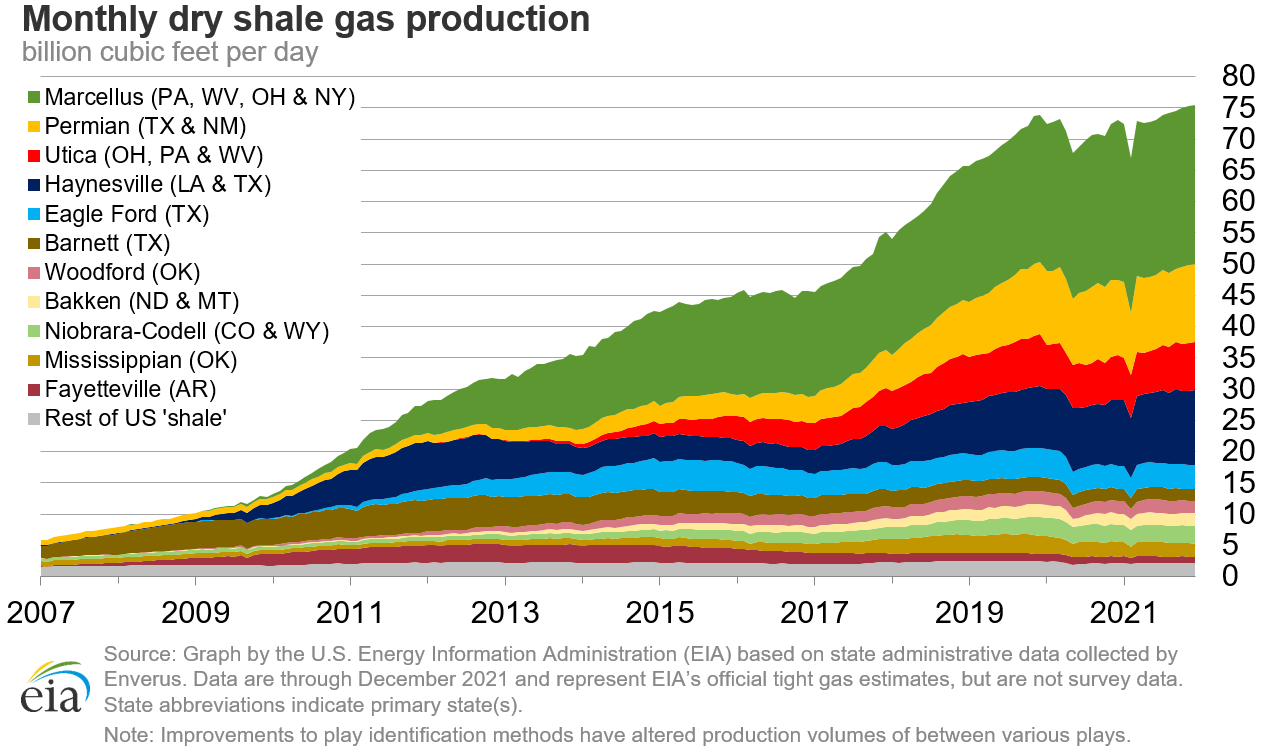In the News:
Natural gas interstate pipeline capacity additions in 2021 are lowest since 2016
Natural gas pipeline capacity additions in 2021 totaled 7.44 billion cubic feet per day (Bcf/d), according to EIA’s recently updated Natural Gas Pipeline Projects Tracker, which was the lowest addition to interstate transmission capacity since 2016. Interstate pipelines are defined as those governed by the Federal Energy Regulatory Commission (FERC) and include pipelines that cross state borders as well as those that serve export demand―both at pipeline border crossings and at terminals exporting liquefied natural gas (LNG).
Approximately two-thirds of the new interstate natural gas pipeline capacity (5.01 Bcf/d) transports natural gas into and within the South Central region, which includes Texas and the Gulf Coast market. Most of the additional capacity serves growing LNG export demand, primarily by improving connectivity between other interstate pipelines and LNG export terminals. Two of the three major new pipeline projects in the South Central region are related to Venture Global’s newly commissioned Calcasieu Pass LNG export terminal in Louisiana:
- Venture Global’s TransCameron pipeline, a 1.90 Bcf/d, 24-mile lateral, which delivers feedgas to the terminal
- Enbridge’s Cameron Extension Project, a 0.75 Bcf/d expansion on the Texas Eastern Transmission pipeline (TETCO) that connects with the TransCameron pipeline
The other major project that increased capacity in the South Central region is the Double E pipeline, a 1.35 Bcf/d, 135-mile pipeline that provides new takeaway capacity out of the Permian producing areas in southeastern New Mexico to the Waha Hub in western Texas.
The Northeast region recorded the second-highest level of new interstate natural gas pipeline capacity (1.60 Bcf/d) in 2021. About half of this new capacity was associated with two related projects. The 0.58 Bcf/d Leidy South Expansion Project on the Transcontinental Pipeline (Transco) increased takeaway capacity out of the Appalachian Basin into East Coast demand markets. In addition to Transco’s expansion project, National Fuel Gas Supply Corporation’s FM 100 Project expanded its system by 0.33 Bcf/d in response to the additional Transco capacity available.
EIA’s Natural Gas Pipeline Projects Tracker is updated quarterly. We expect to update the tracker again in the second quarter of 2022.
Overview:
(For the week ending Wednesday, February 16, 2022)
- Spot Prices: Natural gas spot prices rose at most locations this report week (Wednesday, February 9 to Wednesday, February 16). The Henry Hub spot price rose from $4.06 per million British thermal units (MMBtu) last Wednesday to $4.39/MMBtu yesterday.
- International Spot Prices: International natural gas prices were mixed this report week. Bloomberg Finance, L.P. reports that swap prices for liquefied natural gas (LNG) cargos in East Asia for the balance of February rose $0.53 to a weekly average of $24.82/MMBtu from $24.29/MMBtu last week. At the Title Transfer Facility (TTF) in the Netherlands, the most liquid natural gas spot market in Europe, the day-ahead prices fell $1.48 to a weekly average of $24.46/MMBtu. Prices at TTF are now below prices in East Asia for the first time since the week ending January 19. In the same week last year (week ending February 17, 2021), prices in East Asia and at TTF were $7.89/MMBtu and $6.07/MMBtu, respectively.
- Futures: The price of the March 2022 NYMEX contract increased 70.8 cents, from $4.009/MMBtu last Wednesday to $4.717/MMBtu yesterday. The price of the 12-month strip averaging March 2022 through February 2023 futures contracts climbed 55.2 cents to $4.726/MMBtu.
- Storage: The net withdrawals from working gas totaled 190 billion cubic feet (Bcf) for the week ending February 11. Working natural gas stocks totaled 1,911 Bcf, which is 17% lower than the year-ago level and 12% lower than the five-year (2017–2021) average for this week.
- NGPLs: The natural gas plant liquids (NGPLs) composite price at Mont Belvieu, Texas, rose by 2 cents/MMBtu, averaging $11.18/MMBtu for the week ending February 16. Ethane prices fell 4%, which was less than the 16% decrease in the natural gas price at the Houston Ship Channel. The premium between ethane and natural gas widened by 34%, or 46 cents/MMBtu, to reach $1.84/MMBtu. Prices of heavier NGPLs rose, following the price of Brent crude oil price, which increased 2% week over week. The natural gasoline price increased by 3%, normal butane by 2%, and isobutane and propane by 1%. The propane discount to crude oil increased by 6% for the week ending February 16.
- Rigs: According to Baker Hughes, for the week ending Tuesday, February 8, the natural gas rig count increased by 2 to 118 rigs. The Marcellus gained two rigs, the Eagle Ford dropped one rig, and one rig was added in an unspecified location for a net gain of two rigs. The number of oil-directed rigs increased by 19 to 516 rigs, the largest week-over-week gain since February 2018. The Permian Basin had the largest gain with seven rigs, followed by the Eagle Ford with a gain of five rigs, and the Williston added two rigs. The total rig count now stands at 635, the highest count since April 3, 2020, and 238 rigs more than last year at this time.
Prices/Supply/Demand:
Prices along the Gulf Coast rise in advance of a cold front forecast for the central Lower 48 states. This report week (Wednesday, February 9 to Wednesday, February 16), the Henry Hub spot price rose 33 cents from $4.06 per million British thermal unit (MMBtu) last Wednesday to $4.39/MMBtu yesterday, after dipping to a low for the report week of $3.89/MMBtu last Thursday. According to reporting by IHS Markit, residential and commercial sector consumption of natural gas in the Southeast region decreased by 0.8 billion cubic feet per day (Bcf/d) (17%) this report week, while natural gas consumption by the electric power sector decreased by approximately 0.7 Bcf/d (7%) as a result of above-normal temperatures. Production in the region remained flat at 9.7 Bcf/d. The National Oceanic and Atmospheric Administration (NOAA) forecasts a return to winter weather for the central Lower 48 states with the arrival of a cold front in the region, resulting in increased heating demand and higher natural gas consumption. IHS Markit also reports liquefied natural gas (LNG) feed gas deliveries to LNG terminals in South Louisiana increased for another week, by 240 million cubic feet per day (MMcf/d) (3.5%) to 7.2 Bcf/d. Venture Global, operator of the Calcasieu Pass LNG export terminal in Louisiana, received approval on Monday from the U.S. Federal Energy Regulatory Commission to begin the commissioning process for Block 3, which includes two more liquefaction units at the terminal. TransCameron Pipeline, which transports natural gas to Calcasieu Pass, reports that flows to the terminal reached a record high of 420 MMcf/d on February 16 and feed gas deliveries this report week have averaged close to 350 MMcf/d. LNG has been steadily produced at the terminal since early January.
Prices in the Midwest rise slightly, in line with the Henry Hub price. At the Chicago Citygate, the price increased 53 cents from $3.79/MMBtu last Wednesday to $4.32/MMBtu yesterday. IHS Markit reports Midwest residential and commercial sector consumption of natural gas decreased by 1.4 Bcf/d (11%). Consumption by the electric power generation sector decreased by 0.4 Bcf/d (13%) this report week as temperatures in the Chicago area averaged 29°F, 1°F above normal for the week. IHS Markit also reports that production in the mid-continent region increased by 1.2 Bcf/d this report week to 10.7 Bcf/d, with most of the increase (0.7 Bcf/d) coming from the Anadarko Basin.
Prices rise slightly in the West as a cold-weather front moved into the region. The price at PG&E Citygate in Northern California rose 37 cents, up from $4.44/MMBtu last Wednesday to $4.81/MMBtu yesterday. The price at SoCal Citygate in Southern California increased 44 cents from $3.92/MMBtu last Wednesday to $4.36/MMBtu yesterday. Prices in major supply regions also increased week over week. The price at Malin, Oregon, the northern delivery point into the PG&E service territory, rose 50 cents from $3.63/MMBtu last Wednesday to $4.13/MMBtu yesterday. The price at Sumas on the Canada-Washington border, the main pricing point for natural gas in the Pacific Northwest, rose 41 cents from $3.60/MMBtu last Wednesday to $4.01/MMBtu yesterday. With unseasonably warm weather, total consumption in the region declined to its lowest reported total since September, to an average of 8.8 Bcf/d over the weekend, but has risen rapidly through Tuesday. IHS Markit reports total consumption in the West rose by more than 1.6 Bcf/d between Sunday and Tuesday as a cold front moved into the region. NOAA reports temperatures at Los Angeles International Airport averaged higher than 72°F on Sunday, 15°F above normal, and dropped to average just below 56°F (2°F below normal) yesterday.
Prices in the Northeast remain volatile in response to fluctuating weather patterns. At the Algonquin Citygate, which serves Boston-area consumers, the price went down $4.20 from $8.33/MMBtu last Wednesday to $4.13/MMBtu yesterday. At the Transcontinental Pipeline Zone 6 trading point for New York City, the price decreased 25 cents from $4.04/MMBtu last Wednesday to $3.79/MMBtu yesterday. Prices were volatile during the report week. The Algonquin City Gate price rose to a weekly high of $22.48/MMBtu on Monday as a result of below-normal temperatures in the region, which resulted in higher heating demand; however on Tuesday the price dropped significantly, to $4.69/MMBtu, in advance of another warming trend. Temperatures in New England are forecast to average 16°F above normal going into this weekend. Natural gas demand has been equally volatile in the Northeast during this period. Demand in the residential and commercial sectors declined week over week by 1.1 Bcf/d (7%) to 15.8 Bcf/d, but only after reaching a daily high of nearly 23.0 Bcf/d early this week, according to IHS Markit. Oil-fired electricity generation increased again this report week because of colder-than-normal temperatures at the start of the week. On Tuesday, oil-fired electricity generation accounted for 8% of the electricity supply mix compared with last week when it had fallen to average less than 3% for the week. Additional oil-fired electricity generation displaced natural gas-fired electricity generation, which fell from 54% last week to 48% on Tuesday.
Algonquin Gas Transmission reports that the Exemplar, an LNG carrier capable of regasifying LNG for delivery into the natural gas pipeline system (also known as a floating storage and regasification unit (FSRU)), discharged approximately 638 million cubic feet (MMcf) of LNG at the Northeast Gateway LNG Terminal this week. To date, the FSRU has delivered approximately 2.6 Bcf of LNG into the New England market and an estimated 0.4 Bcf remains onboard in the ship’s LNG storage tanks.
Prices in the Appalachia production region are relatively flat week over week. The Tennessee Zone 4 Marcellus spot price decreased 2 cents from $3.72/MMBtu last Wednesday to $3.70/MMBtu yesterday. The price at Eastern Gas South in southwest Pennsylvania rose 2 cents from $3.65/MMBtu last Wednesday to $3.67/MMBtu yesterday. According to IHS Markit, natural gas production increased 1.0 Bcf/d (3%) to average 33.3 Bcf/d this week. Natural gas consumption in all consuming sectors in the producing area was down 0.7 Bcf/d (6%), but the lower consumption was offset by increased flows to the Southern Corridor and Midwest, which were up 1.1 Bcf/d and 0.6 Bcf/d, respectively, resulting in relatively flat total demand of 41.0 Bcf/d.
The price discount in the Permian Basin production region relative to Henry Hub decreases; production reaches new highs in the region. The price at the Waha Hub in West Texas, which is located near Permian Basin production activities, rose 45 cents this report week, from $3.48/MMBtu last Wednesday to $3.93/MMBtu yesterday. The Waha Hub traded 46 cents below the Henry Hub price yesterday, compared with last Wednesday when it traded 58 cents below the Henry Hub price. According to IHS Markit, natural gas production in the Permian Basin averaged 15.3 Bcf/d, which is a 13% increase from the week before. The largest production increase was in the New Mexico section of the basin, which was up 0.6 Bcf/d (14%) week over week, where improved pipeline connectivity (see In the News section above) has been allowing more produced natural gas to reach the market. Natural gas flows out of the region increased 1.9 Bcf/d (15%) to average 14.1 Bcf/d this week, led by a 1.2 Bcf/d increase in flows to the east into Texas.
U.S. total natural gas supply rises this week with increasing production. The average total supply of natural gas rose 3.2% (3.1 Bcf/d) this week compared with the previous report week, more than offsetting last week's 2.7% week-over-week decline, according to data from IHS Markit. Dry natural gas production grew by 5.1% (4.6 Bcf/d) compared with the previous report week, while average net imports from Canada decreased by 20.2% (1.5 Bcf/d) from last week.
U.S. total consumption of natural gas decreases substantially this week across most sectors. Total U.S. consumption of natural gas fell by 10.9% (11.3 Bcf/d) compared with the previous report week, according to data from IHS Markit. Natural gas consumed for power generation decreased by 12.0% (3.6 Bcf/d), and consumption in the residential and commercial sectors decreased by 15.0% (7.2 Bcf/d) from a week ago. NOAA reported higher daytime temperatures across most of the western, south central, and eastern United States during the current report week. Industrial sector consumption decreased by 1.9% (0.5 Bcf/d) week over week, while natural gas exports to Mexico increased 0.1%. Natural gas deliveries to LNG export facilities (LNG pipeline receipts) averaged 12.6 Bcf/d, or 0.2 Bcf/d higher than last week.
U.S. LNG exports are down by four vessels this week from last week. Twenty-three LNG vessels (eight from Sabine Pass, five from Freeport, four from Cameron, three from Corpus Christi, two from Cove Point, and one from Elba Island) with a combined LNG-carrying capacity of 85 Bcf departed the United States between February 10 and February 16, 2022, according to shipping data provided by Bloomberg Finance, L.P.
Storage:
The net withdrawals from storage totaled 190 Bcf for the week ending February 11, compared with the five-year (2017–2021) average net withdrawals of 154 Bcf and last year's net withdrawals of 227 Bcf during the same week. Working natural gas stocks totaled 1,911 Bcf, which is 251 Bcf lower than the five-year average and 404 Bcf lower than last year at this time.
According to The Desk survey of natural gas analysts, estimates of the weekly net change to working natural gas stocks ranged from net withdrawals of 182 Bcf to 206 Bcf, with a median estimate of 197 Bcf.
The average rate of withdrawals from storage is 9% higher than the five-year average so far in the withdrawal season (November through March). If the rate of withdrawals from storage matched the five-year average of 10.3 Bcf/d for the remainder of the withdrawal season, the total inventory would be 1,415 Bcf on March 31, which is 251 Bcf lower than the five-year average of 1,666 Bcf for that time of year.
More storage data and analysis can be found on the Natural Gas Storage Dashboard and the Weekly Natural Gas Storage Report.
See also:
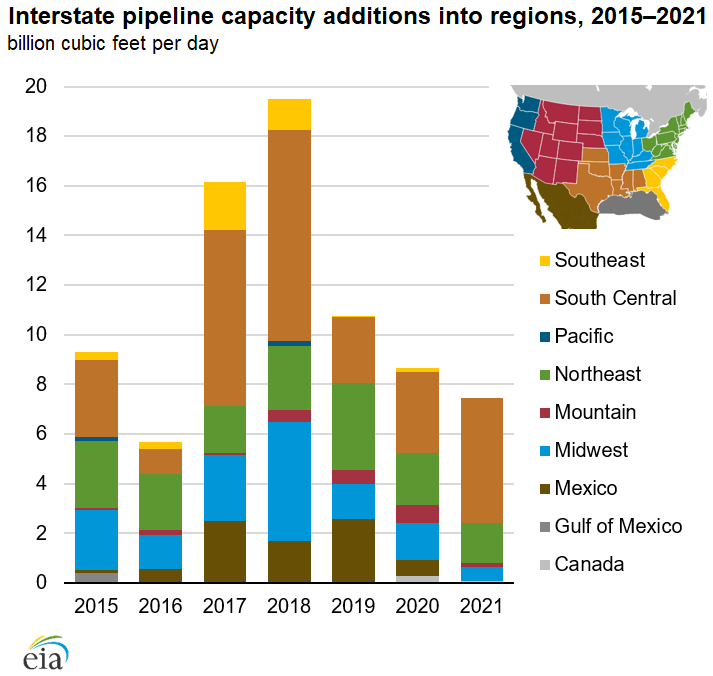 Source: U.S. Energy Information Administration, Natural Gas Pipeline Project Tracker
Source: U.S. Energy Information Administration, Natural Gas Pipeline Project TrackerNote: Only pipeline projects under FERC jurisdiction are included and considered interstate capacity.
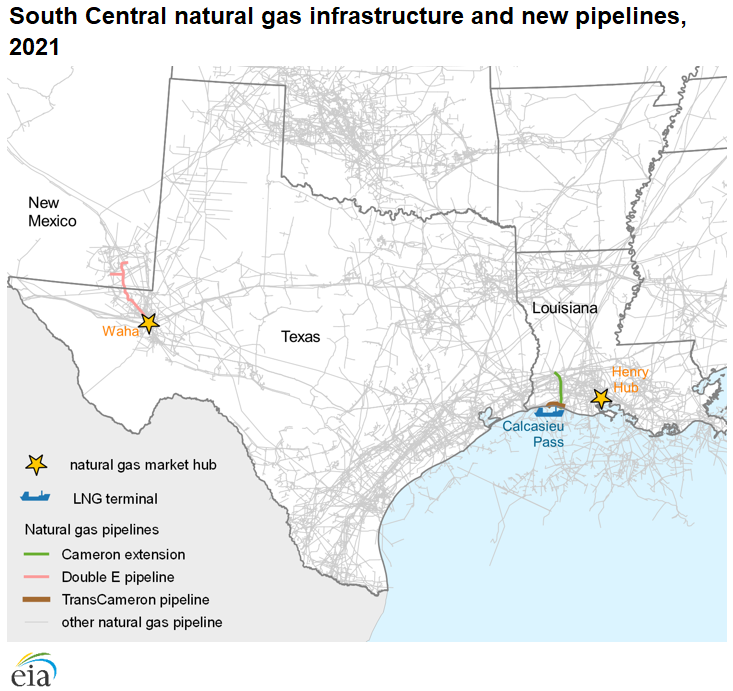 Source: U.S. Energy Information Administration, Natural Gas Pipeline Project Tracker
Source: U.S. Energy Information Administration, Natural Gas Pipeline Project Tracker
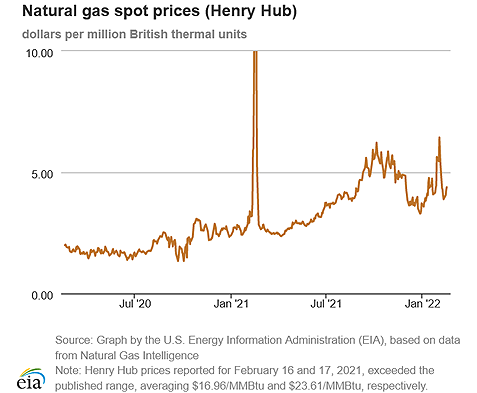
| Spot Prices ($/MMBtu) | Thu, 10-Feb |
Fri, 11-Feb |
Mon, 14-Feb |
Tue, 15-Feb |
Wed, 16-Feb |
|---|---|---|---|---|---|
| Henry Hub |
3.89 |
3.93 |
4.05 |
4.27 |
4.39 |
| New York |
3.47 |
6.65 |
7.00 |
3.83 |
3.79 |
| Chicago |
3.68 |
3.78 |
3.88 |
4.00 |
4.32 |
| Cal. Comp. Avg.* |
3.84 |
3.80 |
4.04 |
4.27 |
4.41 |
| Futures ($/MMBtu) | |||||
| March contract | 3.959 |
3.941 |
4.195 |
4.306 |
4.717 |
| April contract |
3.943 |
3.935 |
4.160 |
4.241 |
4.572 |
| *Avg. of NGI's reported prices for: Malin, PG&E Citygate, and Southern California Border Avg. | |||||
| Source: NGI's Daily Gas Price Index | |||||
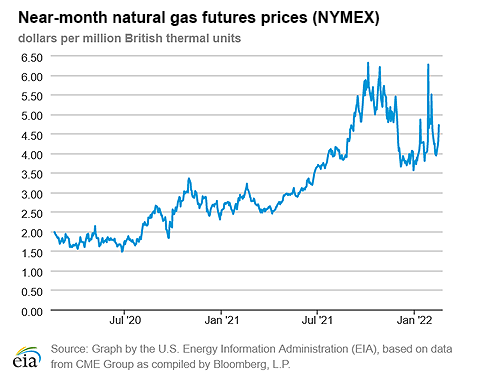
| U.S. natural gas supply - Gas Week: (2/10/22 - 2/16/22) | |||
|---|---|---|---|
Average daily values (billion cubic feet) |
|||
this week |
last week |
last year |
|
| Marketed production | 108.0 |
102.5 |
93.3 |
| Dry production | 95.1 |
90.5 |
83.6 |
| Net Canada imports | 5.8 |
7.3 |
7.3 |
| LNG pipeline deliveries | 0.3 |
0.3 |
0.3 |
| Total supply | 101.2 |
98.1 |
91.2 |
|
Source: Chart by the U.S. Energy Information Administration (EIA), based on data from IHS Markit | |||
| U.S. natural gas consumption - Gas Week: (2/10/22 - 2/16/22) | |||
|---|---|---|---|
Average daily values (billion cubic feet) |
|||
this week |
last week |
last year |
|
| U.S. consumption | 92.0 |
103.3 |
114.8 |
| Power | 26.4 |
30.0 |
31.3 |
| Industrial | 24.7 |
25.2 |
25.0 |
| Residential/commercial | 40.9 |
48.2 |
58.5 |
| Mexico exports | 5.3 |
5.3 |
5.1 |
| Pipeline fuel use/losses | 7.2 |
7.3 |
7.4 |
| LNG pipeline receipts | 12.6 |
12.4 |
8.5 |
| Total demand | 117.1 |
128.4 |
135.8 |
|
Source: Chart by the U.S. Energy Information Administration (EIA), based on data from IHS Markit | |||
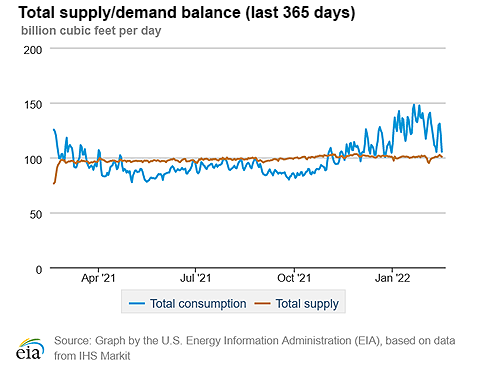
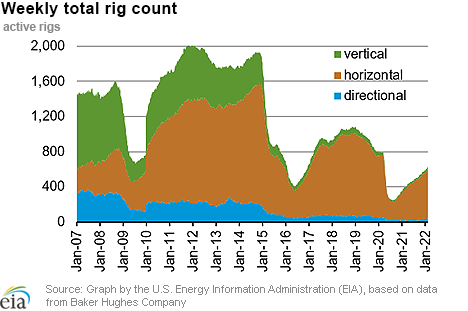
| Rigs | |||
|---|---|---|---|
Tue, February 08, 2022 |
Change from |
||
last week |
last year |
||
| Oil rigs | 516 |
3.8% |
68.6% |
| Natural gas rigs | 118 |
1.7% |
31.1% |
| Note: Excludes any miscellaneous rigs | |||
| Rig numbers by type | |||
|---|---|---|---|
Tue, February 08, 2022 |
Change from |
||
last week |
last year |
||
| Vertical | 28 |
16.7% |
21.7% |
| Horizontal | 574 |
3.4% |
61.2% |
| Directional | 33 |
-2.9% |
83.3% |
| Source: Chart by the U.S. Energy Information Administration (EIA), based on data from Baker Hughes Company | |||
| Working gas in underground storage | ||||
|---|---|---|---|---|
Stocks billion cubic feet (Bcf) |
||||
| Region | 2022-02-11 |
2022-02-04 |
change |
|
| East | 435 |
485 |
-50 |
|
| Midwest | 496 |
552 |
-56 |
|
| Mountain | 114 |
121 |
-7 |
|
| Pacific | 177 |
181 |
-4 |
|
| South Central | 689 |
763 |
-74 |
|
| Total | 1,911 |
2,101 |
-190 |
|
|
Source: U.S. Energy Information Administration Form EIA-912, Weekly Underground Natural Gas Storage Report | ||||
| Working gas in underground storage | |||||
|---|---|---|---|---|---|
Historical comparisons |
|||||
Year ago (2/11/21) |
5-year average (2017-2021) |
||||
| Region | Stocks (Bcf) |
% change |
Stocks (Bcf) |
% change |
|
| East | 491 |
-11.4 |
471 |
-7.6 |
|
| Midwest | 600 |
-17.3 |
565 |
-12.2 |
|
| Mountain | 139 |
-18.0 |
124 |
-8.1 |
|
| Pacific | 246 |
-28.0 |
202 |
-12.4 |
|
| South Central | 839 |
-17.9 |
800 |
-13.9 |
|
| Total | 2,315 |
-17.5 |
2,162 |
-11.6 |
|
| Source: U.S. Energy Information Administration Form EIA-912, Weekly Underground Natural Gas Storage Report | |||||
| Temperature – heating & cooling degree days (week ending Feb 10) | ||||||||
|---|---|---|---|---|---|---|---|---|
HDDs |
CDDs |
|||||||
| Region | Current total |
Deviation from normal |
Deviation from last year |
Current total |
Deviation from normal |
Deviation from last year |
||
| New England | 251 |
-18 |
-18 |
0 |
0 |
0 |
||
| Middle Atlantic | 248 |
-9 |
-11 |
0 |
0 |
0 |
||
| E N Central | 290 |
9 |
-64 |
0 |
0 |
0 |
||
| W N Central | 277 |
-12 |
-111 |
0 |
0 |
0 |
||
| South Atlantic | 163 |
-8 |
0 |
4 |
-3 |
-5 |
||
| E S Central | 192 |
21 |
22 |
0 |
0 |
0 |
||
| W S Central | 156 |
35 |
44 |
0 |
-4 |
-2 |
||
| Mountain | 213 |
1 |
7 |
0 |
-1 |
0 |
||
| Pacific | 76 |
-31 |
-30 |
0 |
0 |
0 |
||
| United States | 208 |
-3 |
-26 |
1 |
0 |
-1 |
||
|
Source: Chart by the U.S. Energy Information Administration (EIA), based on data from the National Oceanic and Atmospheric Administration Note: HDDs=heating degree days; CDDs=cooling degree days | ||||||||
Average temperature (°F)
7-day mean ending Feb 10, 2022
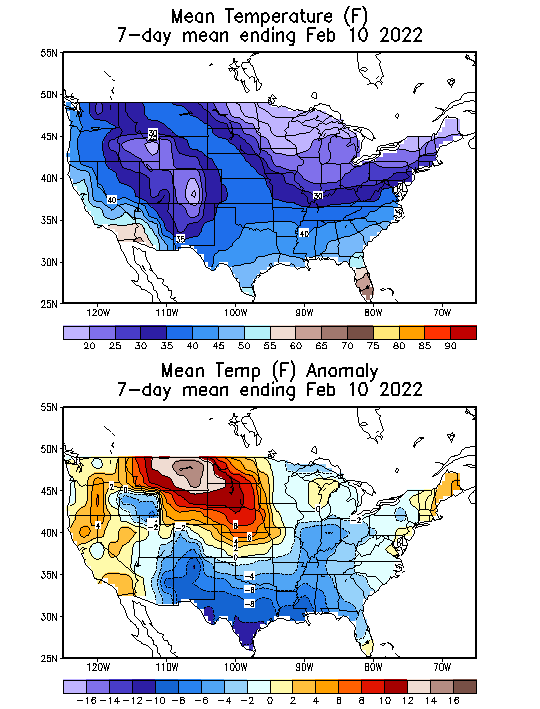
Source: National Oceanic and Atmospheric Administration Note: Image is not available.
Deviation between average and normal (°F)
7-day mean ending Feb 10, 2022

Source: National Oceanic and Atmospheric Administration Note: Image is not available.

